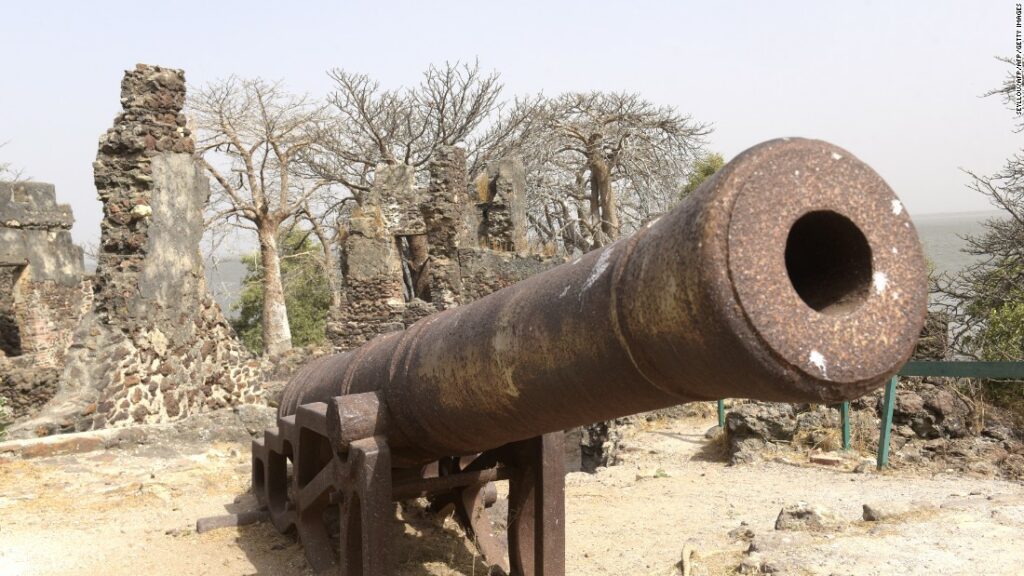(CNN) The island formerly known as James has a dark history.
This speck of land at the mouth of the Gambia river was once a major waypoint of the transatlantic slave trade. African abductees were brutally imprisoned on the island, ahead of being forcibly transported to the US.
“It was the departure point for hundreds of thousands of blacks captured in the Gambia River area from 1588 to 1807,” says historian Hassoum Ceesay, curator of the Gambia National Museum.
The victims included famous rebel Kunta Kinte, who lost a foot resisting the slavers. His story inspired Alex Haley’s 1976 novel “Roots” and the hit TV series of the same name. His legacy has been kept alive in popular culture by artists such as Kendrick Lamar.
Growing public awareness of Kinte’s story and the horrors of slavery has made the island an attraction for tourists and historians.
In 2003, James Island was certified a UNESCO World Heritage Site as a “unique memorial to the Atlantic Slave Trade.” In 2011, James was renamed Kunta Kinteh Island in commemoration of its most famous son.
Today, the site is one of Gambia’s most popular visitor attractions. But it is slowly disappearing.
A police officer walks past cannons on Kunta Kinteh Island.
Slipping away
The Gambia’s unforgiving climate is threatening to erase its dark history.
Kunta Kinteh island is shrinking due to coastal erosion and key sites are at risk.
“Most of the island was reclaimed from the river, and with time and global warming it has drifted back to the river,” says Ceesay.
The seaward side of Fort Bullen, constructed by British soldiers, has suffered erosion and collapsed in places, according to UNESCO.
The new Gambian government acknowledges the problem, which goes beyond the island, but may be ill-equipped to address it.
“Gambia is a low-lying country with erosion on many parts of the coastline,” says Bubacar Jallow, climate change officer at the Ministry of Environment. “We have interventions in various areas but limited resources.”
The site is also affected by tropical storms, which have damaged fragile ruins including a French colonial warehouse named the Compagnie Francaise d’Afrique Occidentale (CFAO).
“Heavy rains and windstorms in August 2016 affected local communities, historic buildings and the villages of Albreda and Juffureh,” says UNESCO Africa programme specialist David Stehl. “The storms caused destruction of property, including the loss of part of the roof of the CFAO building on the Albreda waterfront.”
Many of the island’s monuments have been damaged.
Turning back the tide
UNESCO is planning to restore the CFAO roof, the latest in a series of measures to protect the site.
Seventy meters of sea defenses have been installed off vulnerable parts of the island. Gambia’s government has implemented a public education campaign to emphasize the importance of conservation.
But Jallow believes these efforts must be scaled up in the face of climate threats.
“We need a full vulnerability assessment to inform us of the potential conservation measures,” he says. “If the problems are severe we will try to channel our resources (to the island).”
The Gambia’s government is aware that investment would likely be repaid. Around 22 percent of the country’s GDP derives from tourism, according to the World Travel and Tourism Council, and Kunta Kinteh island is among the most popular attractions.
But Jallow believes that maintaining the memory of slavery is not only The Gambia’s responsibility.
“I think the island is very important for the world, not just for Gambians,” he says.
“I hope the international community will support this cultural heritage.”
Source link : https://amp.cnn.com/cnn/2017/05/03/africa/kunta-kinteh-island
Author :
Publish date : 2017-05-03 03:00:00
Copyright for syndicated content belongs to the linked Source.
